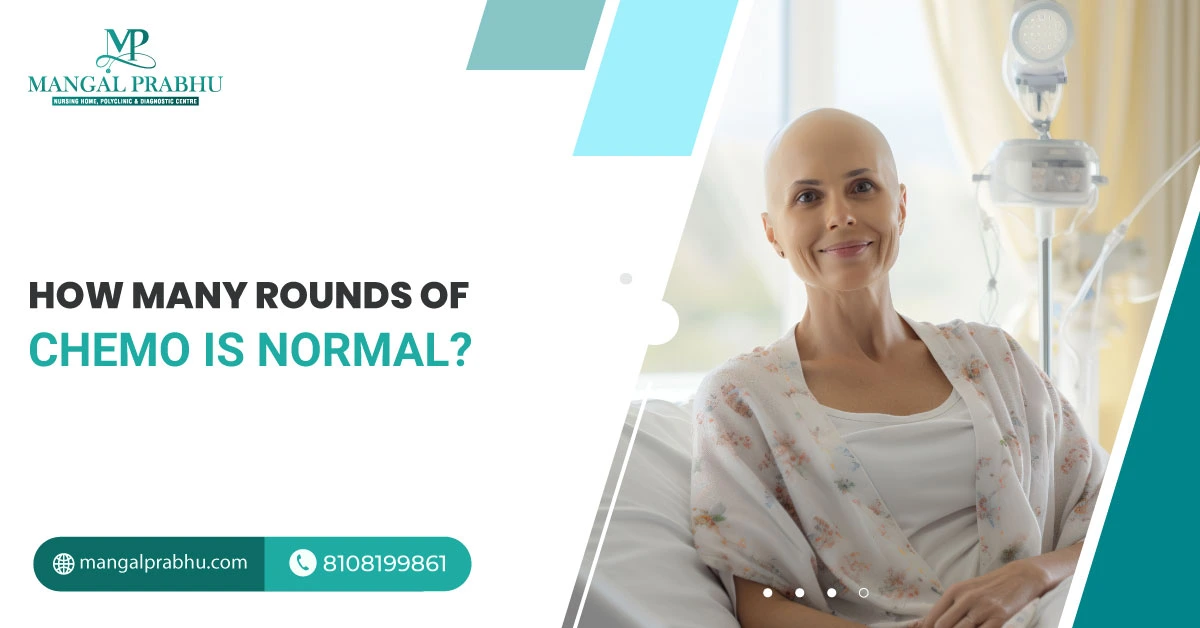
How Many Rounds of Chemo is Normal?
Chemotherapy is one of the effective treatments for many types of cancer. These drugs, combined with radiation therapy, immunotherapy, hormone therapy, and surgery, are administered to prevent cancer from spreading and growing. A cancer specialist in Navi Mumbai recommends chemotherapy in multiple cycles.
This is to ensure that your body gets enough rest before the next cycle begins. It also helps assess how your body and the cancer responds to the medication. In this article, we’ve discussed all you should know about factors affecting chemotherapy duration, how many rounds of chemo is normal, and the chemo cycles. Let’s take a look:
Factors Influencing the Number of Chemo Rounds
The number of chemo sessions you need depends on many factors:
i) Type of Cancer:
Breast and lung cancer, for example, require 4-6 cycles of chemotherapy. Chronic leukemia may require ongoing chemo sessions that can last up to 2 years.
ii) Stage of Cancer:
Cancer that’s diagnosed at an early stage might require fewer chemo rounds compared to the advanced-stage cancer that’s spreading aggressively. Your treatment plan may include chemo sessions before and after surgery.
iii) Patient’s Health:
How your body reacts to the chemo drugs determine the number of chemo rounds required. If your tumor shrinks and your symptoms improve, the oncologist may recommend fewer sessions. If the progress is slow, more rounds might be scheduled.
Typical Chemotherapy Schedules
A normal range for chemotherapy rounds is between 4 and 6 cycles, but as mentioned above, it can vary from patient to patient, depending on the type and stage of cancer. Usually, the sessions start with chemo drugs, which are administered over a few days and are followed by a rest period of 2-3 weeks before another chemo session is planned.
Experts advise that chemotherapy drugs must be given with a rest period, as these medications can kill your fast-growing healthy cells. It’s a common side-effect of chemotherapy. So, while the treatment works wonders for cancer patients by killing the rapidly multiplying cancer cells, it also affects the cells responsible for your hair growth, cells in your mouth, gut, and other places. Your body needs adequate time to replenish these healthy cells.
Individualized Treatment Plan
Treatment is mostly personalized based on the patient’s age, type of cancer, and its aggressiveness. If needed, the chemotherapy regimen can be changed. The doctor decides whether to continue or how the future sessions should be planned based on how your cancer responds to the first few cycles.
Managing Side Effects
The most common side-effects after chemotherapy include fatigue, sore mouth, hair loss, nausea, vomiting, diarrhea or constipation, neuro pain, cognitive issues, weight loss, and low immunity.
Chemotherapy treatment in Navi Mumbai is associated with many side-effects, some of which can cause extreme discomfort and might interfere with your daily activities. Talk to your doctor if the side-effects get severe. They will recommend lifestyle modification, change medication, or switch your chemo regimen to manage side-effects. There’s no exact chemotherapy count. You may need only a couple of sessions to kill cancer completely. Others may need more for the best results.
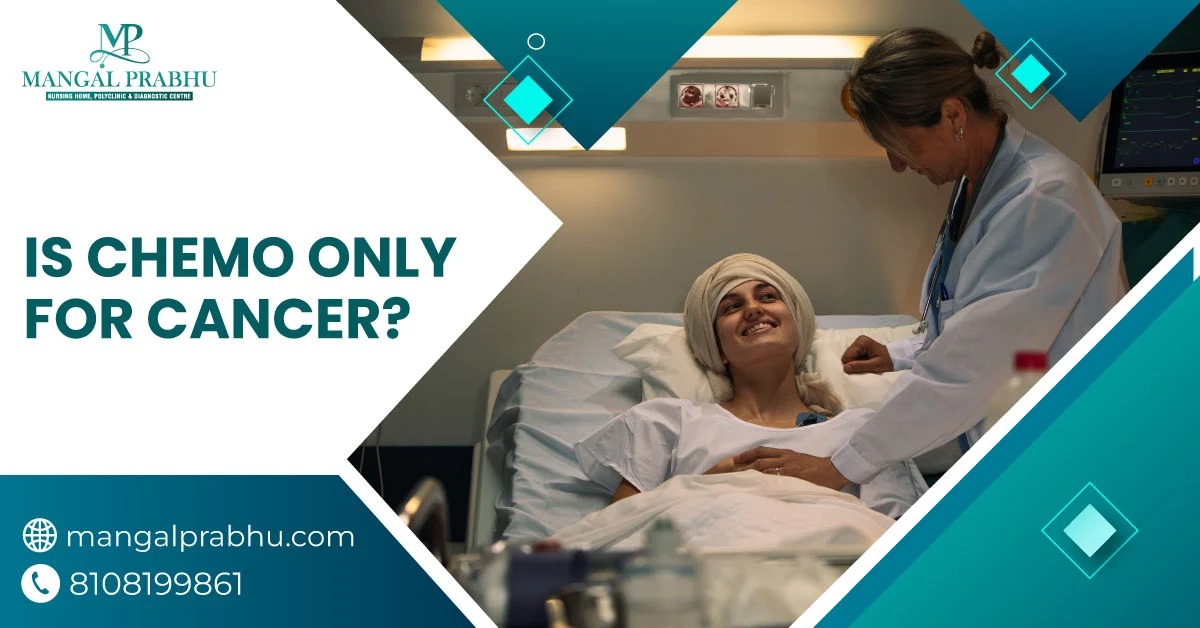
Is Chemo Only for Cancer?
What’s the first word that comes to your mind when you hear the word chemotherapy? Cancer. Chemotherapy is the most common treatment for different types and stages of cancer. Depending on the severity of the cancer, oncologists in Navi Mumbai perform chemotherapy either as a standalone treatment or in conjunction with surgery, radiation therapy, hormone therapy, and other procedures.
The question is, is chemotherapy only for cancer? No! It’s also used to treat certain autoimmune disorders and blood disorders. Let’s see what chemotherapy can treat.
Common Uses of Chemotherapy
For Cancer
More than a hundred types of chemotherapy drugs are used to treat different types of cancer. Cancer cells are known for multiplying rapidly. The initial stage of cancer is often confined to a specific organ, but it can spread to the surrounding tissues, lymph nodes, and organs if left untreated. Treatment gets harder as the cancer reaches an advanced stage.
Chemotherapy drugs kill the rapidly multiplying cancer cells. The goal of the treatment is to stop the cancer cells from growing or replicating. The number of chemotherapies required for each patient can vary depending on their cancer diagnosis and how far it’s spread.
For Non-Cancerous Diseases
Chemotherapy can be used in low doses or high doses for non-cancerous conditions, especially autoimmune disorders.
i) Autoimmune Disorders:
Lupus and other autoimmune disorders, in which your immune system attacks your organs and tissues, can be treated with chemotherapy. The therapy can suppress an overactive immune system.
ii) Bone Marrow Disorders:
Bone marrow diseases in which your bone marrow fails to produce adequate red blood cells might require chemotherapy combined with blood transfusion and bone marrow transplant. Chemotherapy is often performed before a bone marrow transplant to destroy the damaged bone marrow cells.
iii) Infections:
Some types of severe and persistent fungal infections can be treated with chemotherapy. Antifungal agents are used to offer relief to the patient. Viral infections that do not respond to the antiviral medication might also require chemotherapy, especially in patients with compromised immune systems.
Potential Side Effects of Chemotherapy
As mentioned earlier, chemotherapy kills cells that grow rapidly, which might also include the healthy cells in your gut and those responsible for your hair growth. So, side effects are not uncommon after each session. The severity of the side effects and how long they last depends on the chemo drugs you are given and the dosage. Here are possible side-effects of chemotherapy:
- Fatigue
- Hair loss
- Mouth sores
- Memory loss (also called chemo brain)
- Fertility issues
- Nausea and vomiting
- Loss of appetite
- Diarrhea or constipation
The side effects can vary from person to person. These are short-term issues that resolve on their own once the treatment stops and the new cells start to grow. Chemotherapy is also associated with long-term side effects, such as damage to your vital organs, like the heart, lungs, and reproductive system.
Conclusion
You can learn more about different types of chemotherapies and multiple methods used to administer the chemotherapy drugs into your body at the chemotherapy hospital in Navi Mumbai.
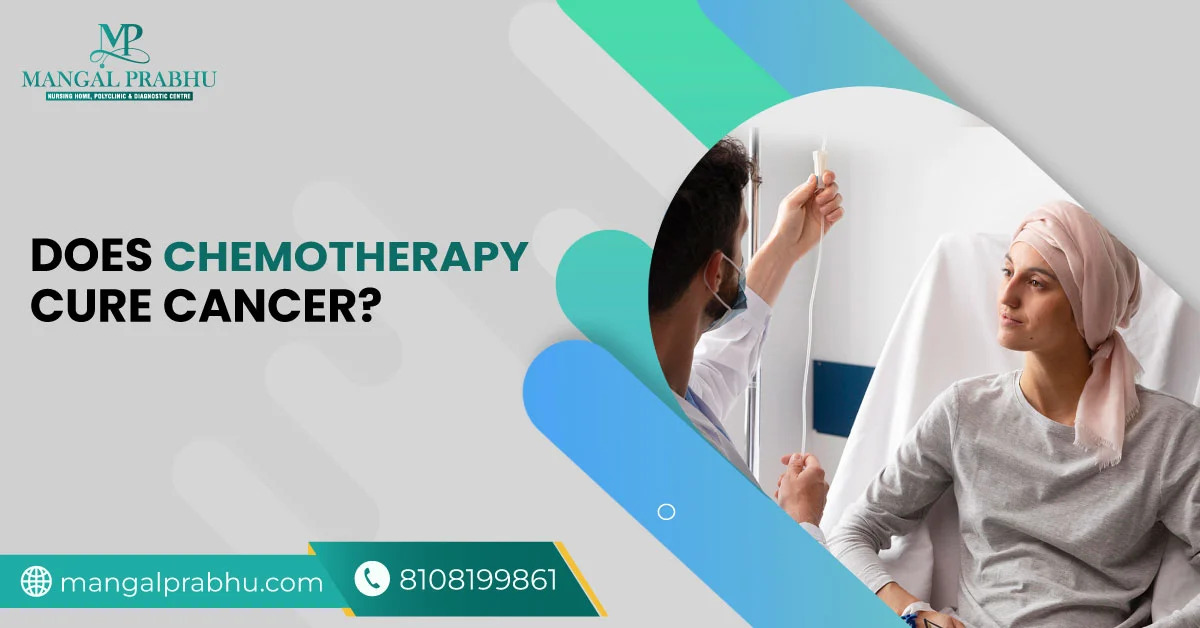
Does Chemotherapy Cure Cancer?
Recovery from cancer is not a cakewalk. The first thing that strikes our mind when it comes to cancer is chemotherapy. It’s a treatment used to kill cancer cells through intravenous administration of the drugs.
These drugs are designed to destroy the rapidly multiplying cells, thus inhibiting cancer growth. While chemotherapy treatment in Navi Mumbai is quite effective in treating cancer, the procedure comes with many side effects. Besides, there’s no guarantee it will cure cancer and prevent relapse.
How Chemotherapy Works
Depending on the type and stage of cancer, chemotherapy can be used as a standalone procedure or in conjunction with radiation therapy and surgery. It can shrink the tumor and destroy cancer cells. Most chemotherapy drugs are given intravenously, but your doctor might recommend a topical application, a single injection shot, or pills.
An oncologist in Navi Mumbai will tell you the number of chemotherapy sessions you need to undergo to kill cancer. Then, based on how your body responds to the treatment, your doctor will either stick to the plan or advise additional treatment, such as surgical removal of the tumor, radiation therapy, or hormone therapy, for the best outcome.
Effectiveness of Chemotherapy
The effectiveness of chemotherapy can vary for each patient. It depends on the type of cancer, the patient’s overall health, the size of the tumor, and how far it’s spread. However, studies show that those exposed to chemotherapy have a better survival rate than those who never undergo chemo. The sooner you report your symptoms and get an accurate diagnosis, the higher your survival rates.
Note that cancer can return even after you are declared cancer-free. Some types of cancer have a chance of relapse, requiring more rounds of chemotherapy. Your oncologist will schedule regular follow-up visits to ensure the cancer has not returned.
Limitations of Chemotherapy
The chemo session isn’t always painful, especially not for those taking it through pills and topical. Intravenous chemo and injections can hurt a little, but it’s nothing more than a slight burning sensation.
Chemotherapy is used to destroy the rapidly growing cells in your body. That’s how it helps kill cancer fast. However, cancer cells are not the only cells that multiply quickly. The cells in your skin, hair follicles, digestive tracts, and other parts of the body also grow fast.
Cancer treatment can also destroy these healthy cells, leading to side effects such as hair loss, fatigue, constipation, diarrhea, vomiting, loss of appetite, and infection. The good news is that the side effects of chemotherapy last for a short while, usually until your treatment stops. Some side effects are, however, permanent. They include infertility, heart problems, and early menopause.
Conclusion
Chemotherapy is an effective way to kill cancer, but the treatment comes with side effects and is usually advised with surgery and other procedures. Ask your oncologist about the success rate of chemotherapy and the side effects. Fortunately, some types of cancer disappear completely following the chemotherapy and don’t require additional treatment. But there’s always a chance of a relapse.
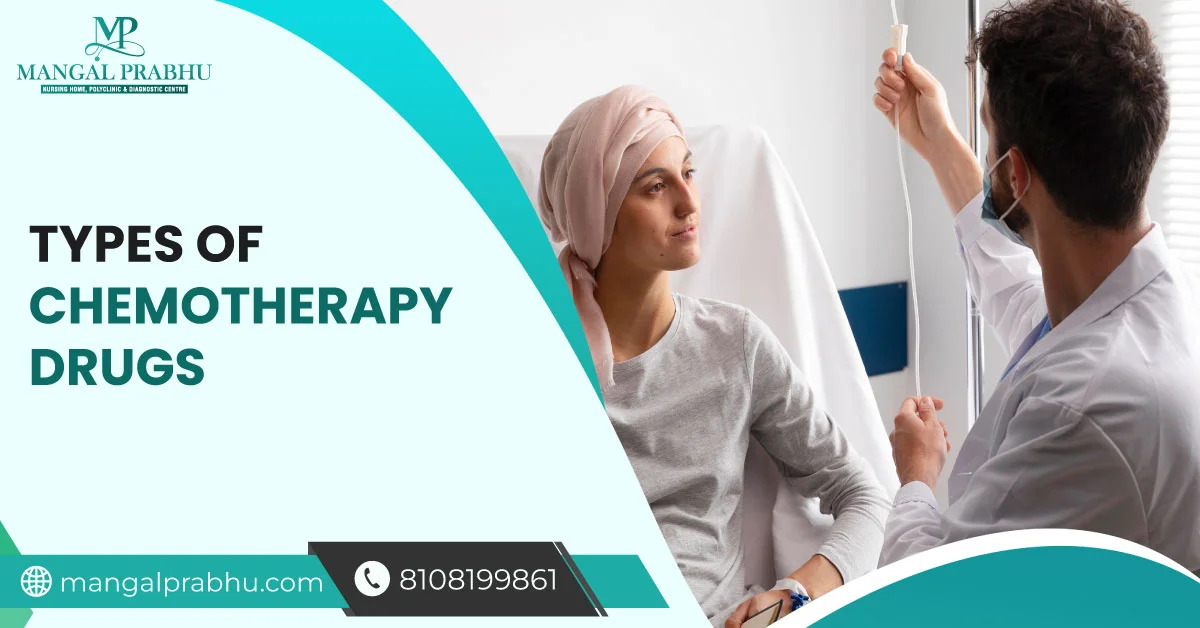
Types of Chemotherapy Drugs
Chemotherapy—the most commonly used treatment approach for cancer—is believed to kill most types of the fastest-growing cells in the human body. The treatment involves different types of drugs, which are effective for various forms and stages of cancer.
These drugs, however, come with certain side effects, as they tend to kill healthy cells, too. It’s important to discuss the benefits and potential risks of chemo with a cancer specialist in Navi Mumbai before considering it. In the meantime, let’s see what chemotherapy involves and how it treats cancer.
Common Types of Chemotherapy Drugs
Chemotherapy drugs are categorized into the following types:
i) Alkylating Agents:
These cancer-killing cells destroy the DNA within the rapidly growing cells, thus preventing their multiplication and growth. The drugs are mainly used for cancers that develop gradually. Examples of alkylating agents include melphalan, temozolomide, cisplatin, busulfan, and Chlorambucil.
ii) Antimetabolites:
These drugs work by pretending to be the nutrients a cell requires for growth, eventually destroying the cancer cells by starving them to death.
iii) Anti-tumor Antibiotics:
These antibiotics destroy the DNA cells that tend to replicate quickly.
iv) Plant Alkaloids:
Mitosis is a medical procedure that affects the ability of cancer cells to grow and divide. Plant Alkaloids, also called mitotic inhibitors, contain the same compound that plants use to protect themselves from predators.
How Chemotherapy Drugs Work
Normal cells in the human body follow a cell cycle, copying DNA material to multiply and then dying when their work is done. Cancer cells, however, never die. They keep replicating the DNA within them and divide rapidly, spreading throughout the body.
These cells form tumors, which, in turn, affect your healthy organs. The goal of chemotherapy treatment in Navi Mumbai is to disrupt this cell cycle by killing cancer cells or interfering with their ability to divide.
Benefits of Chemotherapy Drugs
- It kills cancer cells so that they don’t grow and spread.
- It can shrink the tumor so that your surgeon can surgically remove it.
- The treatment increases your chances of living a healthy and longer life.
Potential Side Effects
While chemotherapy is an effective treatment for different types of cancers, it comes with its share of side effects. The treatment kills other fastest-growing cells in your body, such as the blood-forming cells or the hair follicles. The procedure can lead to:
- Hair loss
- Mouth ulcers
- Digestive issues like vomiting, diarrhea, and constipation
- Loss of appetite
- Fatigue
Tips for Managing Side Effects
Your healthcare provider will prescribe anti-nauseous drugs that can help fight nausea and vomiting. Likewise, depending on your symptoms, they will recommend medications that keep your digestive system in good shape and prevent other side effects. Here’s what else may work:
- Take ample rest
- Practice meditation, yoga, and exercise daily
- Eat small and frequent meals
- Use high-quality hair care products to keep your scalp moisturized and nourished
- Consider counseling
Conclusion
Chemotherapy has saved the lives of many cancer patients. The disease, which was once considered life-threatening, is now treatable with chemotherapy. Chemotherapy can be used as a standalone procedure or in conjunction with surgery and radiation therapy for the best outcome.
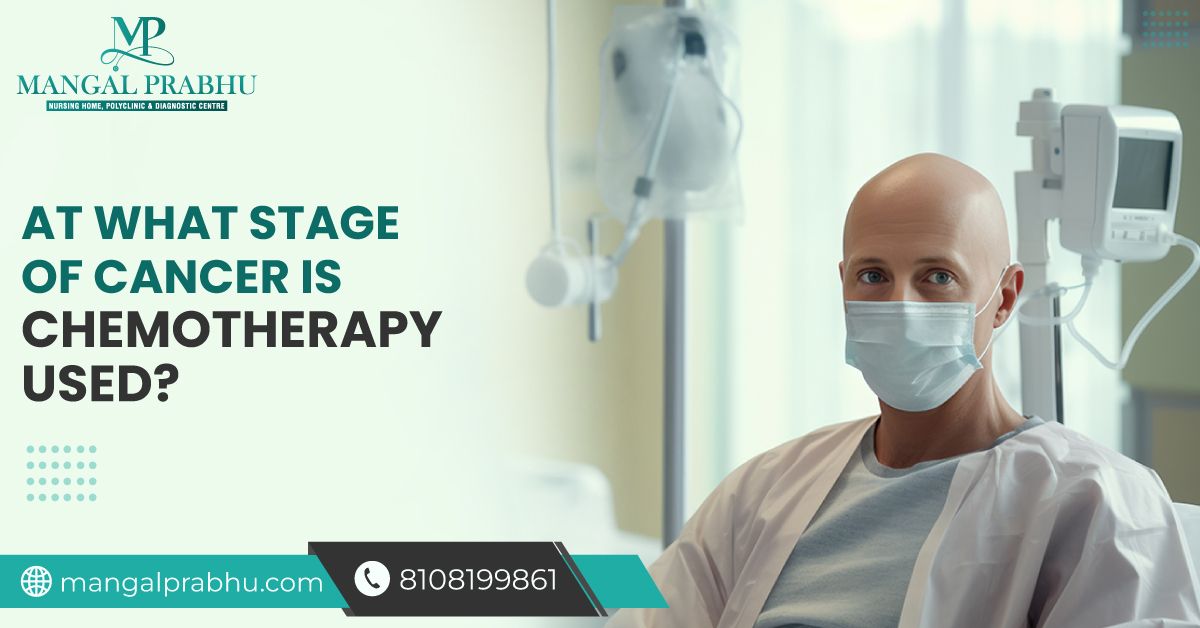
At What Stage of Cancer Is Chemotherapy Used?
Chemotherapy is a combination of medications used to kill cancer cells that are growing aggressively and spreading to your different organs. Chemotherapy treatment in Navi Mumbai is recommended for patients diagnosed with different stages of cancer.
It’s considered an effective treatment option for all types of cancers. The type of chemotherapy your doctor advises depends on the stage, type, and severity of the cancer. They might also factor in your age and health goals to determine the most suitable treatment option.
The Different Stages of Cancer
Chemotherapy can be given for stage I to stage IV cancer patients. Most types of cancer are categorized into four stages, and the diagnosis is done based on how aggressive the cancer cells are, where they have spread, and the patient’s health. For most types, cancer in its first stage is restricted to a specific organ, while the same in stage IV is considered metastatic cancer that has spread to the surrounding organs, probably throughout the body.
Here’s how chemotherapy is planned for different stages of cancer.
Stage 1:
Chemotherapy combined with surgery
Stage 2:
A surgical removal of the malignant tumor and several sessions of chemotherapy.
Stage 3A:
Chemotherapy with surgery or surgery followed by chemotherapy, radiation therapy, and immunotherapy, depending on the location of the cancer. If the cancer can’t be removed surgically, then a combination of chemotherapy, immunotherapy, and radiation therapy is prescribed.
Stage 3B and 3C:
Chemotherapy with multiple rounds of radiation therapy followed by surgery and immunotherapy.
Stage 4:
Chemotherapy, targeted therapy, surgery (if possible), followed by more rounds of chemotherapy.
Types of Chemotherapy Drugs
Chemotherapy drugs are a combination of medications consisting of the following:
i) Alkylating Agents:
These are responsible for destroying the DNA of the replicating cancer cells.
ii) Antimetabolites:
These drugs can destroy cancer cells when they are about to grow out of control in your body. Antimetabolites work for breast, ovarian, and other types of cancer.
iii) Antitumor:
The medication changes the DNA structure of cancer cells, restricting their growth and multiplication inside the body. Mitotic inhibitors are also commonly used to treat cancer cells, but they contain a compound that might destroy healthy cells, as well. So, their use is often limited to certain types of cancers.
Benefits of Chemotherapy
Chemotherapy is the most viable cancer treatment for people diagnosed with cancer in different stages and severity statuses. Here’s how it benefits:
- Restrict the growth of the tumor or shrink its size to make surgical removal of the cancer possible
- Prevent the cancer cells from dividing
- Reduces the risk of relapse
Potential Side Effects
Oncologists in Navi Mumbai recommend chemotherapy after considering your age, size, type of cancer, and your health. Before you choose this treatment, know that it comes with side effects. These may vary depending on the chemo drugs used, but some common side effects found in most patients include:
- Fatigue
- Nausea and vomiting
- Diarrhea
- Hair loss
- Mouth sores
- Loss of appetite
- Anemia
- Weakness in muscles
Schedule an appointment with your healthcare to discuss the most suitable chemotherapy option, the length of the treatment, and the risks.
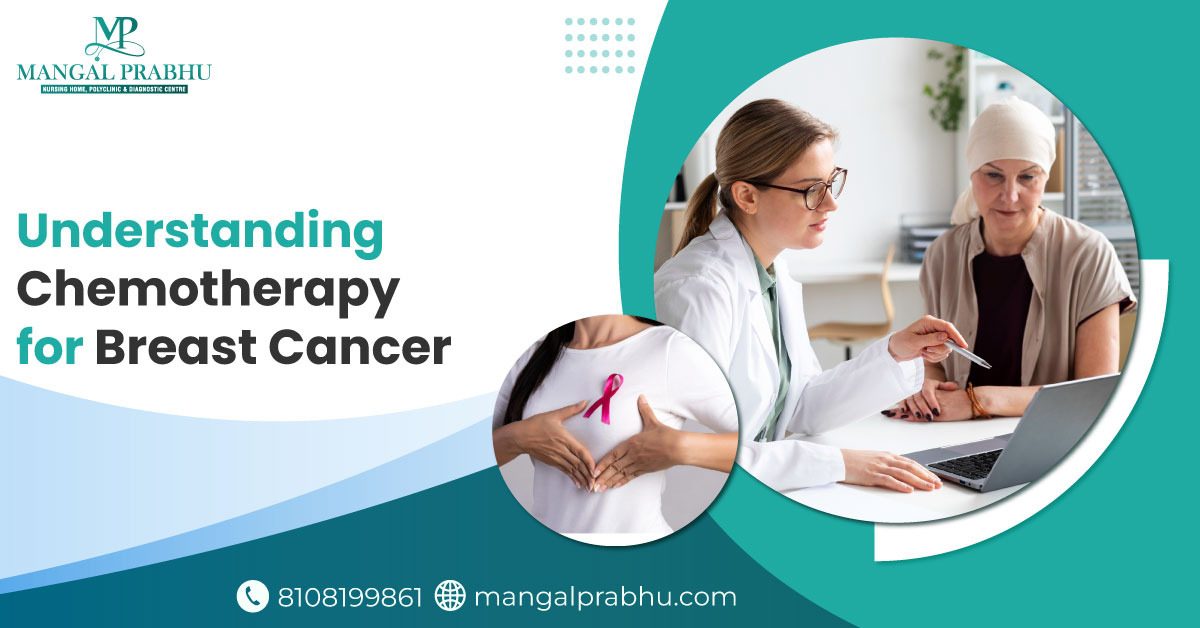
Understanding Chemotherapy for Breast Cancer
When it comes to combating breast cancer, a multidimensional approach is often required. Chemotherapy Treatment in Navi Mumbai is pivotal in eradicating cancer cells throughout the body. Breast cancer is a formidable adversary, and in the arsenal of treatments available, chemotherapy stands as a powerful weapon against its progression. In this comprehensive guide, you can learn more about chemotherapy for breast cancer, exploring its mechanisms, risks, benefits, and crucial role in the overall treatment landscape.
What is Chemotherapy?
Chemotherapy is a medical treatment that utilizes drugs to target and destroy rapidly dividing cells, such as cancer cells. Unlike localized treatments such as surgery or radiation therapy, chemotherapy circulates throughout the bloodstream, reaching cancer cells that may have spread to other body parts.
How Does Chemotherapy Work for Breast Cancer?
Chemotherapy is a dynamic player in the breast cancer treatment arena, strategically deployed at different phases of the patient’s journey. In the pre-surgical phase, known as neoadjuvant chemotherapy, it shrinks tumors, facilitating more effective surgical removal.
Post-surgery, adjuvant chemotherapy takes the stage, aiming to eradicate any residual cancer cells, minimizing the risk of recurrence. The drugs utilized in chemotherapy exert their impact by disrupting the cell division process, impeding the growth and spread of cancer cells.
This dual approach, targeting both pre- and post-operative stages, showcases the versatility and effectiveness of chemotherapy in comprehensively managing breast cancer.
What Are the Risks and Side Effects of Chemotherapy?
While chemotherapy is a potent weapon, it is not without its challenges. Common side effects include fatigue, nausea, hair loss, and a heightened infection susceptibility. It is essential to acknowledge these potential side effects while recognizing that advancements in medical science continuously strive to minimize the impact on a patient’s quality of life.
Also Read: How Chemotherapy Is Done?
What Are the Benefits of Chemotherapy for Breast Cancer?
The benefits of chemotherapy in treating breast cancer are multifaceted.
1) Tumor Size Reduction
Chemotherapy effectively targets and reduces the size of breast tumors, facilitating a more manageable surgical intervention.
2) Risk Reduction for Cancer Recurrence
By eradicating cancer cells that may remain after surgery, chemotherapy significantly lowers the risk of cancer recurrence.
3) Enhanced Surgical Success
Administering chemotherapy post-surgery ensures the elimination of any residual cancer cells, enhancing the success of surgical procedures.
4) Holistic Treatment Approach
Integrating chemotherapy into a comprehensive treatment plan addresses cancer from multiple angles, leading to a more thorough and effective therapeutic strategy.
5) Long-Term Survival Rates
The multifaceted benefits of chemotherapy contribute to improved long-term survival rates, offering individuals battling breast cancer a more favorable prognosis.
6) Systemic Cancer Cell Targeting
Chemotherapy’s systemic nature allows it to target cancer cells throughout the body, addressing potential metastases and minimizing the risk of distant recurrence.
Conclusion
In breast cancer treatment, chemotherapy plays a dynamic and indispensable role. Its ability to target cancer cells systemically makes it a crucial component of a comprehensive treatment strategy. For individuals confronting breast cancer, collaboration with a specialized medical team, including a Breast Cancer Specialist in Navi Mumbai, is essential. Mangal Prabhu Hospital is a beacon of healthcare excellence, providing state-of-the-art facilities and a dedicated team of experts to guide patients through their breast cancer journey.

How Chemotherapy Is Done?
Introduction to Chemotherapy
The journey through cancer treatment often involves various therapeutic approaches, and one of the most well-known is chemotherapy. This widely recognized treatment plays a crucial role in combating cancer cells, and understanding how chemotherapy is administered can empower individuals facing cancer. In Navi Mumbai, centers like Mangal Prabhu Hospital offer comprehensive care under the expertise of skilled Oncologists in Navi Mumbai.
What is Chemotherapy?
Chemotherapy, often referred to as “chemo,” is a medical treatment that employs powerful drugs to target and destroy rapidly dividing cells. While cancer cells are the primary target, chemotherapy can also affect healthy cells that divide quickly, such as bone marrow, digestive tract, and hair follicles.
What is the Purpose of Chemotherapy?
The primary goal of chemotherapy is to eliminate or control the growth of cancer cells. It can be used at different stages of cancer treatment:
a) Before Surgery:
Neoadjuvant chemotherapy aims to shrink tumors before surgery, making them more manageable to remove.
b) After Surgery:
Adjuvant chemotherapy is administered after surgery to eliminate any remaining cancer cells and reduce the risk of recurrence.
c) Primary Treatment:
In cases where surgery or radiation therapy may not be viable, chemotherapy is the immediate treatment.
d) For Palliative Care:
In advanced stages, chemotherapy can alleviate symptoms and improve the quality of life.
How Chemotherapy is Done?
The process of chemotherapy involves several key steps:
A) Consultation and Planning:
Patients undergo a thorough consultation with an oncologist before initiating chemotherapy. A personalized treatment plan is developed based on cancer type, stage, overall health, and medical history.
B) Drug Administration:
Chemotherapy drugs can be administered in various ways, including intravenously (IV), orally (in the form of pills or liquids), or through injections. The chosen method depends on the specific drugs and the patient’s condition.
C) Treatment Cycles:
Chemotherapy is often administered in cycles, each consisting of a treatment period followed by a rest period. This approach helps minimize damage to healthy cells and allows the body to recover.
D) Outpatient or Inpatient:
Depending on the intensity and duration of treatment, chemotherapy sessions may be conducted on an outpatient basis, allowing patients to return home afterward or in an inpatient setting for more extensive regimens.
What are the Side Effects of Chemotherapy?
While chemotherapy is a powerful tool against cancer, it can also lead to side effects due to its impact on average, rapidly dividing cells. Common side effects may include:
- Fatigue
- Nausea and Vomiting
- Hair Loss
- Bone Marrow Suppression
- Gastrointestinal Issues
- Mouth Sores
- Neuropathy
Conclusion
Chemotherapy is a dynamic and evolving aspect of cancer treatment, representing a cornerstone in the fight against this formidable disease. In Navi Mumbai, facilities like Mangal Prabhu Hospital, with dedicated oncologists, play a vital role in providing comprehensive Chemotherapy Treatment in Navi Mumbai. While the process can be challenging, understanding the purpose, procedure, and potential side effects empowers individuals on their cancer journey. With ongoing advancements in medical science, chemotherapy significantly improves outcomes and enhances the quality of life for those undergoing cancer treatment.
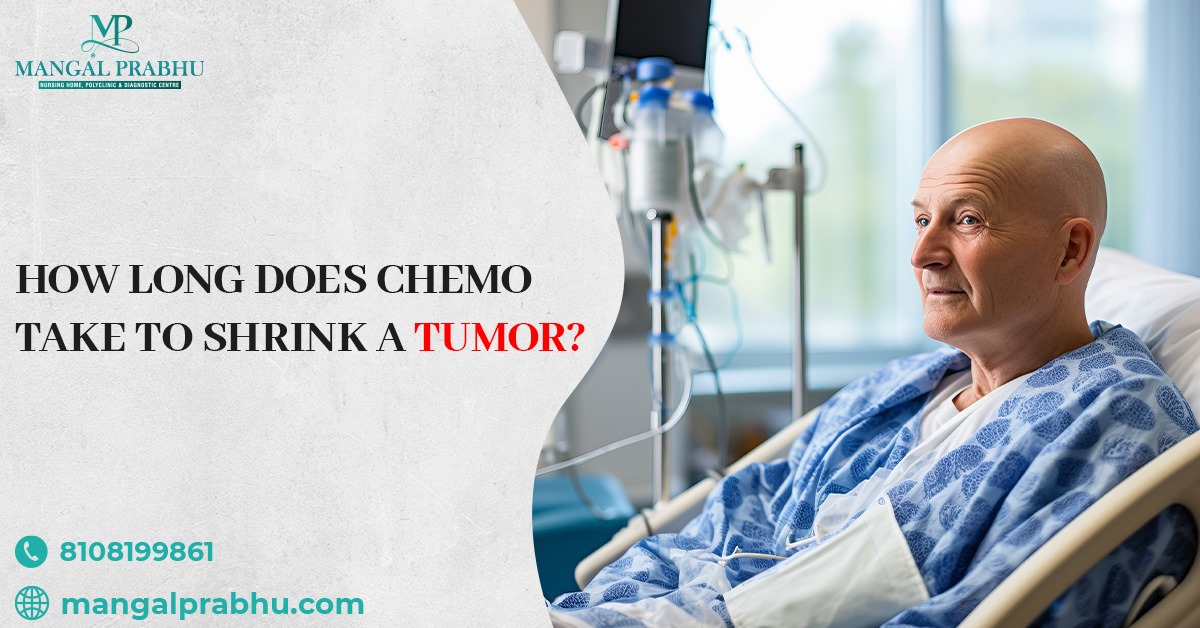
How Long Does Chemo Take To Shrink A Tumor?
What is Chemotherapy, and How Does it Work
Chemotherapy is a medical treatment that uses powerful drugs to target and destroy cancer cells. It is a widely used approach in cancer treatment, either as a standalone therapy or combined with other treatments such as surgery or radiation therapy. Chemotherapy works by interfering with the growth and division of cancer cells, ultimately leading to their death. Visit an Oncologist in Navi Mumbai at Mangal Prabhu Hospital to learn more about chemotherapy treatment and its need.
Factors that Affect How Long Chemotherapy Takes
The duration it takes for chemotherapy to shrink a tumor can vary widely from person to person and depends on several factors:
i) Type of Tumor
The type of cancer and its aggressiveness play a significant role in determining how long chemotherapy will take to shrink a tumor. Some cancers respond more rapidly to chemotherapy than others.
ii) Size of Tumor
Larger tumors may require more time to respond to chemotherapy and show noticeable shrinkage. Smaller tumors may respond more quickly.
iii) Location of Tumor
The tumor’s location within the body can influence the time it takes for chemotherapy to have an effect. Tumors in easily accessible areas may respond more rapidly than those in challenging locations.
iv) Patient Health
A patient’s overall health and immune system strength can impact their response to chemotherapy. Patients in better health may tolerate and respond to treatment more effectively.
Treatment Options for Shrinking Tumors
Chemotherapy is just one of the treatment options available for shrinking tumors. The choice of treatment depends on the type and stage of cancer. Here are some common treatment options:
- Surgical removal of the tumor is often the first choice for solid tumors that are localized and haven’t spread. In some cases, surgery may be followed by chemotherapy to eliminate any remaining cancer cells.
- Radiation therapy uses high-energy rays to target and shrink tumors. Depending on the cancer type, it may be used with chemotherapy or as a standalone treatment.
- Immunotherapy enhances the body’s immune system to recognize and attack cancer cells. It has shown promising results in treating certain types of cancer.
Challenges Associated with Chemotherapy
While chemotherapy is a valuable tool in cancer treatment, it comes with challenges and potential side effects, including:
- Chemotherapy can cause various side effects.
- Some tumors may become resistant to chemotherapy over time, making it less effective.
- Chemotherapy is often administered in cycles, with rest periods in between. The overall duration of treatment can vary, ranging from a few weeks to several months or more.
Conclusion
The duration it takes for chemotherapy to shrink a tumor can vary based on several factors, including the type of tumor, its size, location, and the patient’s overall health. Chemotherapy is just one of the many treatment options available. Hence, you should choose the treatment after consulting with an oncologist specializing in cancer care.
At Mangal Prabhu Hospital, a leading Chemotherapy Center in Navi Mumbai, experienced oncologists work closely with patients to develop personalized treatment plans. Whether it’s chemotherapy, surgery, radiation therapy, or a combination of treatments, the goal is to provide the most effective and comprehensive care to combat cancer.
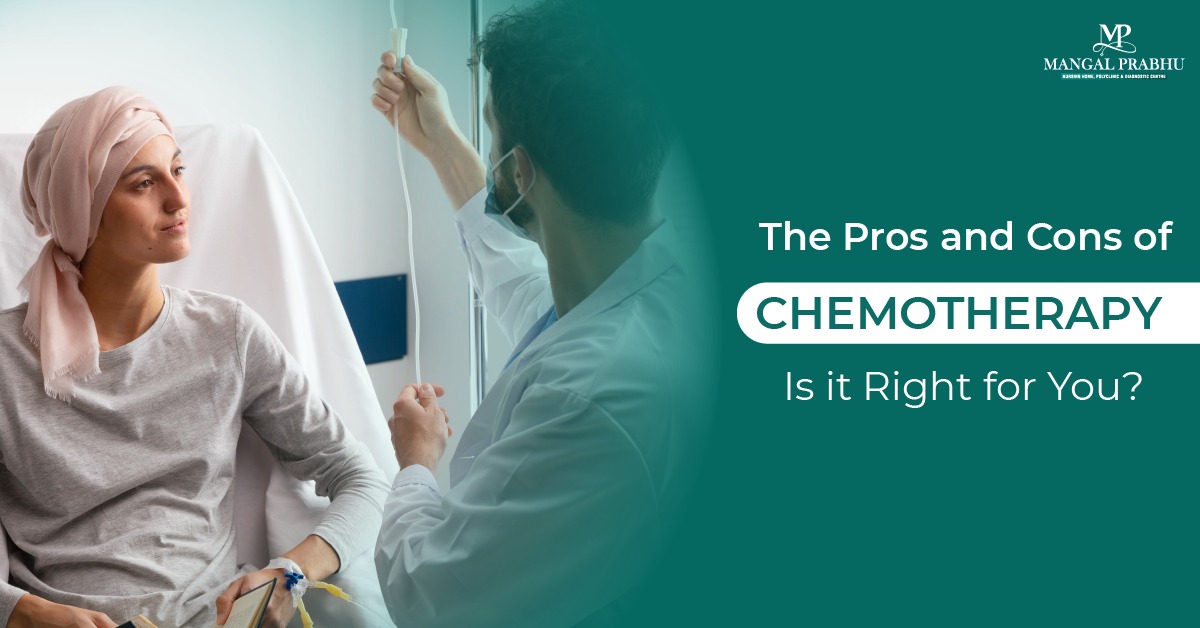
The Pros And Cons Of Chemotherapy: Is It Right For You?
Chemotherapy is the most effective treatment plan for treating and killing cancer cells by preventing their slowing and spreading growth. It is the most common cancer treatment to prevent tumor growth and destroy cancer cells. However, this guide will help you understand the advantages and disadvantages associated with chemotherapy so you can also make the right decision.
What is Chemotherapy & How Does It Work?
Chemotherapy is a kind of cancer treatment that is also known as chemo. It includes various drugs and treatment plans such as immunotherapy, hormone therapy, and targeted therapy against different types of cancer. Chemotherapy can also be paired with radiation therapy to cure cancer and ease its symptoms.
Chemotherapy works by destroying the cancer cells and stopping them from spreading. However, Mangal Prabhu Hospital is the best chemotherapy center in Navi Mumbai and uses the best tools and techniques to provide the fastest and most effective treatment. Their oncologist may use chemotherapy in various ways, including neoadjuvant, adjuvant, palliative, and curative therapy.
The Pros of Chemotherapy – Understanding the Benefits
Chemotherapy is very advantageous for cancer patients. Some of the benefits of this treatment are:
- It kills the cancer cells in the early stages of the disease.
- It reduces the intensity of the tumor before radiation therapy or surgery.
- Chemotherapy helps prevent and slow down the growth of cancer cells.
- Help in fighting the cancer cell, and other treatments work better.
- It made surgery possible by eliminating the cancer’s dead cells and reducing its spread.
Also Read: Chemotherapy: Types, Treatment, And Side Effects!
The Cons of Chemotherapy – Possible Side Effects & Risks
Chemotherapy not only kills cancer cells, but it also slows down the growth of healthy cells. It damages healthy cells and may cause side effects. However, some of the most common disadvantages and side effects of chemotherapy are:
- Hair loss
- Mouth sores
- Nausea
- Fatigue
- Patients must visit hospitals regularly to continue therapy, which can be tiring.
- It may not help all cancer patients.
- The recovery time and effects may differ from person to person.
Deciding Whether Chemotherapy is Right for You
Chemotherapy benefits all cancer patients or people with early signs of cancer but has some potential side effects. However, it would be best to decide and ask your loved ones whether you should start chemotherapy to treat your issue. It is the most effective way to treat cancer and may be very important for patients who do not need immediate treatment, such as prostate cancer or indolent lymphoma.
However, your physician may recommend chemotherapy if there is a sign that your cancer may grow in the future to prevent the cancer cells from spreading, or they may also suggest it if it has already spread to kill harmful cells.
Conclusion
If you have been diagnosed with cancer or it has already spread, it would be best to begin your cancer treatment as soon as possible. However, you can consider the best hematologist oncologist in Navi Mumbai, Mangal Prabhu Hospital, for the best cancer treatment. They offer the highest quality treatment with their standard healthcare plan at an affordable price, so everyone can get the best treatment without worrying about anything.

6 Warning Signs of Breast Cancer
Breast tissue can become cancerous and evolve into breast cancer. Breast cancer develops when the cells there start to divide and grow in an uncontrollable manner, resulting in a tumour or lump. Via the bloodstream or lymphatic system, these aberrant cells can also infiltrate neighbouring tissues or move to other regions of the body.
To increase the likelihood of survival, early detection and treatment of breast cancer are crucial. According to a Cancer Specialist in Navi Mumbai, clinical breast checks, breast MRIs, and other screening procedures can aid in the early detection of breast cancer, when it is most curable.
Depending on the kind and stage of cancer, treatment options for breast cancer may include surgery, radiation therapy, chemotherapy, hormone therapy, or targeted therapy, say the experts in breast cancer treatment in Navi Mumbai.
Also Read: WHAT TO KNOW ABOUT BREAST CANCER?
The following are the 6 types of breast cancer warning signs:
- A bulge or enlargement in the breast or underarm region or close-by alterations in breast size or form
- Nipples that are sensitive or dripping
- Changes in the breast or nipple’s skin tone or texture
- Pain experienced in any breast region
- Breast or nipple swelling or redness
- Palpable Nodule or Lymph Node
Palpable Nodule or Lymph Node
Usually seen in the neck, groyne, or beneath the arms, a palpable nodule or lymph node is a bulge that can be felt or touched on the body. Nodules or lymph nodes that can be felt are frequently the results of an infection, inflammation, or injury, but they can also signal a more serious problem, like cancer.
The lymphatic system, which aids the body in battling illnesses and infections, includes lymph nodes. Little, bean-shaped lymph nodes are filled with immune cells that can assist the body in recognising and combating invading invaders.
The lymph nodes might swell and become palpable when there is an infection or inflammation in the body because they are working to combat the illness. A palpable lymph node, however, may occasionally be an indication of cancer that has progressed from its initial sites, such as breast cancer or melanoma.
It’s crucial to contact your healthcare practitioner for an evaluation to ascertain the cause and, if necessary, proper treatment if you find a palpable nodule or lymph node.
Conclusion:
It’s crucial to remember that not all breast lumps are malignant and that some breast tumours may not even exhibit any symptoms. To find out the cause and, if required, seek treatment, it’s crucial to contact your healthcare physician if you experience any of these warning signs.
